|
Chasing the Monsoon
... through Rajasthan
Text and photographs: Sanjay Singh Badnor
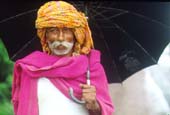 It is the most awaited season in India. As the cool, moisture-laden
winds waft across the country, the earth seems to come alive again
in a green burst of glory. It's the season of fertility, of hope,
of expectation. It is the most awaited season in India. As the cool, moisture-laden
winds waft across the country, the earth seems to come alive again
in a green burst of glory. It's the season of fertility, of hope,
of expectation.
I decided to celebrate the monsoon this year -- the season commences in late June or early July
and lasts right upto September -- by travelling across the western Indian
desert state of Rajasthan. It was, as far as I was concerned,
the best way of experiencing the rejuvenation of a land which
battles for survival each year against the scorching summer.
My eight-day itinerary encompassed a 1,500 km start-to-finish journey
that began at New Delhi. I would first go to Bikaner, situated
in northern Rajasthan, then across the north-eastern desert belt
to Jaipur, the capital city. And from there onwards to Kota in the south-eastern
Rajasthan before finally retracing my steps back to Delhi.
Most travel guide books recommend
the winter months of November to March as ideal for
visiting Rajasthan. I discovered that the monsoon and the post monsoon months are an equally enchanting time to be in Rajasthan.
The first leg of my trip began with a train journey. The
Bikaner Mail departed from the quaint Serai Rohila station in
old Delhi, late one evening and reached Bikaner the following
morning. At daybreak, we were in the heart of the desert, a few
hours away from Bikaner. The surrounding landscape, which otherwise
would have been an endless stretch of scrubby bush and sand, was
now covered with a velvety coat of short green, grass.
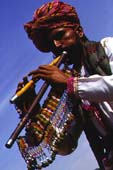 Bikaner is the lesser known of the three towns that make up the desert triangle; the other
two being Jodhpur and Jaisalmer.
Yet, it has a great deal to offer the discerning traveller -- forts, palaces and temples and the vast desert at its door step. There are the charming bazaars that hawk a variety of arts and crafts. In fact, Bikaner is now being promoted
by the Rajasthan Tourism department as one of the major destination of the
90s. Bikaner is the lesser known of the three towns that make up the desert triangle; the other
two being Jodhpur and Jaisalmer.
Yet, it has a great deal to offer the discerning traveller -- forts, palaces and temples and the vast desert at its door step. There are the charming bazaars that hawk a variety of arts and crafts. In fact, Bikaner is now being promoted
by the Rajasthan Tourism department as one of the major destination of the
90s.
A camel festival is organised every January to boost the tourist
influx into Bikaner, as well as to encourage camel breeders to participate
in what is dubbed as the state's only 'camel extravaganza'. A
camel band, camel polo, an opportunity to sample dairy products
made from camel milk and the breath-taking fire-dance typical
of the Bikaner region are some of the highlights of this two-day
festival, which has now become a major annual attraction.
Bikaner, located on the old caravan route linking central Asia,
India and the sea, was for long a major trading centre. It was founded
in 1485 AD by prince Bika, son of Rao Jodhaji, the ruler of Marwar-Jodhpur,
who wished to form his own separate kingdom. The town is encircled by
imposing battlements and is perched at a slight elevation above the surrounding desert . Its roads undulate through colourful bazaars. The reddish-pink local
sandstone dominates most of the city's handsome buildings.
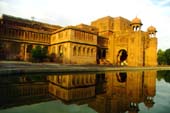 The sky was heavily overcast as I made my way from Bikaner's railway
station to my hotel, the magnificent Lalgarh Palace. It was built
by Maharaja Ganga Singh in 1902 in memory of his father Maharaja
Lal Singh. An imposing carved, red sandstone edifice of graceful
proportions set amidst spacious, lush, green lawns, it was designed
by the British architect Sir Swinton Jacob and constructed by
local sculptors. Lalgarh Palace represents a successful blending
of renaissance style with traditional Rajput architectural form. The sky was heavily overcast as I made my way from Bikaner's railway
station to my hotel, the magnificent Lalgarh Palace. It was built
by Maharaja Ganga Singh in 1902 in memory of his father Maharaja
Lal Singh. An imposing carved, red sandstone edifice of graceful
proportions set amidst spacious, lush, green lawns, it was designed
by the British architect Sir Swinton Jacob and constructed by
local sculptors. Lalgarh Palace represents a successful blending
of renaissance style with traditional Rajput architectural form.
Today, it has been partly converted into a luxury hotel by the
Welcomgroup chain of hotels. Yet, its oriental facade, profusion
of pavilions, intricately carved balconies and balustrades
merges with its occidental interiors, profusely embellished with
Belgian glass crystal chandeliers.
It's time to move around the city. I begin with Junagarh Fort,
which is a must for every tourist visiting Bikaner. It is one
of the few forts in the country which has never been conquered
by invaders. Built by Raja Rai Singh (1571-1611), who was also
one of Akbar's distinguished generals, the fort is a rather impressive
stronghold to which additions were made by rulers over the next
three centuries.
It houses a series of 37 palaces, of which the Chandra Mahal,
the Phool Mahal and the Anup Mahal are definitely worth a visit. Junagarh, when
seen from the uppermost terrace, is an amazing amalgamation of
courtyards, galleries, balconies and bell towers. The fort, which
is open to the public, also houses an excellent museum.
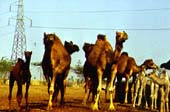 After lunch I set off for Jorbeer; 10 km from the city. A research centre on camels and as well as a rather interesting camel
breeding farm is located at Jorbeer. A visit to this centre is
an excellent opportunity to familiarise oneself with the habits,
lifestyle and other features of this incredible 'ship of the desert'.
The camel plays an important role in this region in defence and
civil law and order in the border areas, as well as for postal
services in the otherwise inaccessible desert areas! After lunch I set off for Jorbeer; 10 km from the city. A research centre on camels and as well as a rather interesting camel
breeding farm is located at Jorbeer. A visit to this centre is
an excellent opportunity to familiarise oneself with the habits,
lifestyle and other features of this incredible 'ship of the desert'.
The camel plays an important role in this region in defence and
civil law and order in the border areas, as well as for postal
services in the otherwise inaccessible desert areas!
Next, I make a pilgrimage to Karni Mata, the tutelary deity of
the Rathore rulers of Bikaner. Another incarnation of the Goddess
Durga, her temple lies 32 km from Bikaner at a place called Deshnoke.
The temple's striking feature is the presence of innumerable rats,
who freely scamper about the temple and are even present in the
inner sanctum. Visitors and pilgrims are forewarned that, if they
happen to injure or kill one of these venerated vermin, they
would have to buy redemption by donating a rat made out of gold
to the temple.
Exhausted after the day's hectic schedule, I retrace my steps
to Lalgarh Palace. The evening finds me sitting in the subtly
lit courtyard, under an ink-blue, star-strewn sky and listening
to the strains of the soothing sitar, while the other musicians play
a light Indian classical melody. I am transported into another
world. The music echoes through the maze of palace corridors.
The following morning is spent, shopping and browsing through
Bikaner's colourful bazaars. Camel hide products, carpets, woollen
items, jhootis or Rajasthani footwear and the famous snack
of Bikaner -- the bhujia -- are available all over the
market.
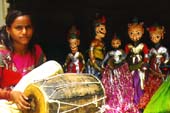 Back in my hotel, I witness a delightful puppet show performed
with great dedication by a father-daughter duo. Later, I head
towards Kolayat, another pilgrim centre located 50 km on the highway
to Jaisalmer. The Kolayat temple is dedicated to a saint and stands
besides sacred, lotus-covered lake. Back in my hotel, I witness a delightful puppet show performed
with great dedication by a father-daughter duo. Later, I head
towards Kolayat, another pilgrim centre located 50 km on the highway
to Jaisalmer. The Kolayat temple is dedicated to a saint and stands
besides sacred, lotus-covered lake.
Early next morning, I was on my way to Jaipur. It is a 300 km ride by cab.
A slight drizzle begins as I halt for a few moments at Devi Kund
on the outskirts of Bikaner and pay homage at the marble cenotaphs
which commemorate the former rulers of Bikaner.
The drive to Jaipur is mostly through the desert region. But the
monsoon has turned the landscape into a lush, green, belt, dotted
with the occasional sand dune. At midday, I reach the Shekhavati
region of north-eastern Rajasthan. This country has been dubbed Rajasthan's
'open air art gallery' as the area abounds with scores of ornately
frescoed havelis or mansions belonging to trading families
of the region.
Shekhavati frescoes are 18th and 19th century images that provide
insights into the growth and development of the people and the
region. In fact, the frescoed mansions, which were really commissioned
around the turn of the century, are a curious mix of the traditional
and colonial styles of art.
For the past several decades, these havelis were lying
in a state of neglect and decay but, today, the booming tourism
has seen several of these havelis restored and converted
into hotels.
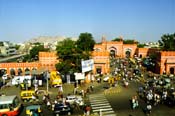 Late in the afternoon, I reached the Pink City of
Jaipur. Presently the capital city of Rajasthan, Jaipur's first foundation stone
was laid in 1727 AD; it was India's first planned city. Late in the afternoon, I reached the Pink City of
Jaipur. Presently the capital city of Rajasthan, Jaipur's first foundation stone
was laid in 1727 AD; it was India's first planned city.
The original plan visualised a spacious and elegant city, built
in a simple grid system. Seven blocks of buildings were divided
by wide, tree lined avenues and each building was embellished
by a variety of architectural decorations. At its heart lay the
city palace, covering two blocks. Jaipur was surrounded by seven
formidable gates, which were closed at night to ensure security.
Today, Jaipur has expanded rapidly outside the original fortified
walls. However, the distinct characteristics that set it apart from other towns of its era
have been carefully preserved and incorporated.
I stayed at Welcomgroup's Rajputana Palace hotel
situated in the centre of the city. The hotel, though totally
modern, offers plenty of facilities of all sorts. And I enjoyed the regal ambience
and refined sophistication of the hotel which has been built along the lines of
a haveli.
| 
